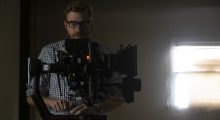Erik Messerschmidt
-
“David Initially Said, ‘What if We Do the Whole Movie Handheld?'”: DP Erik Messerschmidt on The Killer

The Killer begins with an assassin (Michael Fassbender) in a half-completed WeWork office awaiting the arrival of his latest target. As he waits, he details his vocational mantras for the audience in voiceover: stick to the plan. Don’t improvise. Never yield an advantage. Forbid empathy. Fassbender proceeds to miss his shot and spends the rest of the film breaking each and every one of those tenets in the chaotic aftermath. Many of the pieces written about the film have pointed out perceived similarities between the film’s methodical, detail-oriented titular character and the perfectionist reputation of its director, David Fincher. However, […]
by Matt Mulcahey on Jan 11, 2024 -
“We Don’t Find Shots, We Build Them”: DP Erik Messerschmidt on Mank, Lens Flare Painting and Native Black and White

In 1941, a 25-year-old Orson Welles made one of cinema’s most auspicious debuts by directing, co-writing, starring in and producing Citizen Kane. With Mank—David Fincher’s look at the evolution of Kane’s screenplay—cinematographer Erik Messerschmidt makes an impressive feature bow of his own. After working his way up through the ranks of grip and electric and earning DP credits on the shows Legion, Mindhunter and Fargo, Messerschmidt’s very first fiction feature has landed him in the midst of Oscar conversation. With Mank now streaming on Netflix, Messerschmidt spoke with Filmmaker about deep focus, high ISOs and painting in lens flares; and how even […]
by Matt Mulcahey on Dec 22, 2020 -
The Mankalorian: Two Approaches to Digitally Captured 35mm Looks

The last time I wrote about film color for this magazine was on the ways 35mm shooting and digital color combined in Uncut Gems and Star Wars: The Rise of Skywalker to create contemporary looks strongly engaged with the past, resulting in what we might call a look “more filmic than film.” David Fincher’s Mank, along with a second season of the Star Wars TV series The Mandalorian, gives us an opportunity to consider how digital and celluloid tendencies combine from the opposite direction—both were shot digitally, then graded to explicitly evoke celluloid. Once again, color grading and capture format […]
by Jessica Dunn Rovinelli on Dec 9, 2020 -
“If a Director Feels the Need to Move the Camera Simply to ‘Make It Interesting,’ It’s Likely an Indicator the Scene Itself Isn’t That Interesting”: DP Erik Messerschmidt on Mindhunter, Season Two

When David Fincher transitioned from music videos to feature films in the 1990s, the descriptors “glossy,” “slick” and “stylized” were frequently affixed to his work. Those adjectives were often aimed as pejoratives, categorizing Fincher as a technical virtuoso who created shiny but hollow thrillers. Watching the second season of Netflix’s Mindhunter—executive produced and partially directed by Fincher—the evolution of the filmmaker’s aesthetic is striking. As FBI profilers Bill Tench (Holt McCallany) and Holden Ford (Jonathan Groff) interview America’s most notorious serial killers, the camera rarely moves. Instead, it unobtrusively observes. What hasn’t changed over the years is Fincher’s unwavering exactitude, […]
by Matt Mulcahey on Sep 17, 2019 -
DP Erik Messerschmidt on Shooting Netflix’s Mindhunter with a Custom Red Xenomorph

When mere mortals gear up for a job, they are restricted to selecting cameras currently in existence. Not David Fincher. Fincher has long hated all the gak required to make a digital cinema camera functional: a wireless transmitter to get signal to video village, the add-ons to provide wireless iris and focus control, the assistant camera’s onboard monitor hanging off the side — all the things that turn a small, lightweight camera body into a labyrinth of cables and breakout boxes. Red Digital Cinema responded by making Fincher his own set of custom Weapon Red Dragons for use on the […]
by Matt Mulcahey on Oct 26, 2017
